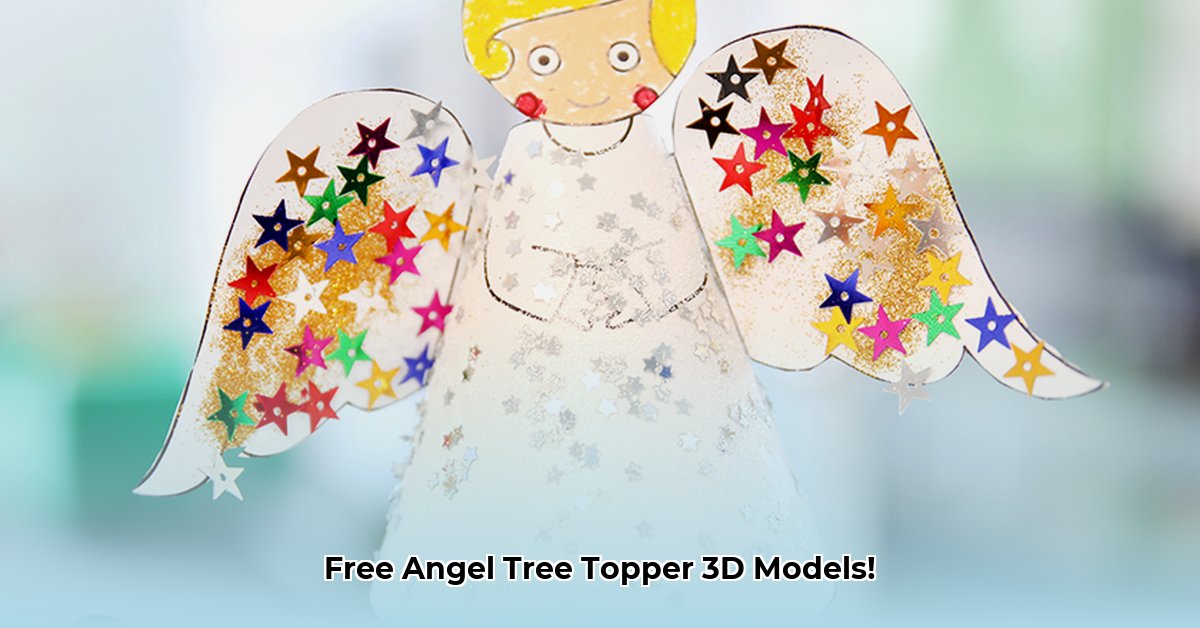
Ready to ditch the same old store-bought Christmas tree toppers and create something truly unique? This year, let's elevate your holiday decor with a stunning, 3D-printed angel tree topper! This guide will walk you through downloading, preparing, and printing your very own personalized celestial masterpiece.
Finding the Perfect Angelic Design: A Virtual Ornament Hunt
First, you'll need to find an angel design that captures your heart. Luckily, the internet is brimming with free 3D printable models. Spend some time browsing – it's like a virtual Christmas ornament treasure hunt! Consider the level of detail: intricate designs are breathtaking but might require longer print times. Always check multiple views of the model before downloading to ensure you're completely satisfied with every angle. Think about the style – is it a classic cherub, a modern minimalist design, or something whimsical and fun?
Getting Ready to Print: Prepping Your Download
After selecting your perfect angel design, download the file (likely an STL file – the standard for 3D printing). Take a quick look at the file size; larger files usually mean more detailed models, but they may also demand longer print times and more filament.
Before printing, carefully examine the model. Does it need extra support structures? These temporary supports prevent delicate parts from sagging during printing. Most 3D printing software automatically suggests supports, but always double-check their placement.
Printing Your Angel: A Step-by-Step Guide to Festive Fabrication
Now for the exciting part – bringing your angel to life! Here's your step-by-step guide to 3D printing success:
Software Selection: Choose your 3D printing software (Cura, PrusaSlicer, Simplify3D are popular choices). Each has unique features, so experiment to find your favorite.
Model Import: Import your downloaded STL file into your chosen software; this is usually a simple drag-and-drop operation.
Fine-Tuning Your Settings: This is where the magic happens! Adjust print settings based on your filament type (PLA is beginner-friendly), nozzle size, and layer height. Thinner layers create smoother details, but increase print time. Experiment to find the perfect balance between detail and speed. Did you know that experimentation is key to mastering 3D printing?
Support Structure Placement (If Necessary): Add support structures if your software suggested them. Improperly placed supports can ruin your print, so meticulous placement is key.
Print Preview: Before starting the print (crucial!), always review the preview. This visual representation shows your printer's movements, allowing you to identify and resolve potential issues like collisions or poorly placed supports. This preventative measure saves you time, filament, and frustration. Nearly 90% of printing failures can be prevented by careful preview checks.
Initiate the Print: Once everything looks perfect, initiate the print! Relax and watch your angel materialize (or go do something else; the print time depends on the design and settings).
Finishing Touches: After printing, gently remove support structures. Light sanding or filing can smooth imperfections, delivering a professional finish.
Troubleshooting: Addressing Common Printing Challenges
Even experienced 3D printing enthusiasts occasionally face challenges. Here are some common problems and their solutions:
Failed Prints: Don't despair if your first attempt isn't perfect! Common causes include poor bed adhesion (the model not sticking to the print bed properly), incorrect temperature settings, clogged nozzles, or design flaws. Thoroughly review your settings, clean your print bed meticulously, and verify the integrity of your model file.
Warped Prints: Warping typically indicates poor bed adhesion. Try cleaning your print bed thoroughly, adjusting the temperature settings, or using a small amount of glue stick to enhance filament grip.
Layer Problems: Uneven layers often result from a clogged nozzle, inconsistent filament flow, or issues with print speed and flow settings.
Filament Selection: Material Matters
Your choice of filament significantly impacts your angel's appearance and longevity.
| Filament Type | Advantages | Disadvantages |
|---|---|---|
| PLA | Easy to print, biodegradable, widely available | Can be brittle, less durable than others |
| ABS | Strong, durable, impact-resistant | Trickier printing, produces fumes |
| PETG | Durable, excellent layer adhesion | More challenging to print than PLA |
Experimentation is part of the fun! Have you considered trying different filament colors for a unique look?
Creating your 3D-printed angel is a rewarding journey. While challenges might arise, the joy of crafting a truly unique, personalized ornament far outweighs any setbacks. Your custom angel will become a cherished holiday keepsake for years to come! And isn't that the most rewarding part of the holiday season?
Choosing the Right 3D Printing Filament: A Guide to Material Selection
Selecting the right filament is pivotal to creating a stunning angel tree topper. The material greatly affects the final look, strength, and durability of your holiday decoration.
Key Considerations:
- PLA: Beginner-friendly, easy to print, biodegradable.
- ABS: Durable and strong, but requires a heated bed and careful management.
- PETG: Balances ease of use and durability, a great all-around choice.
- PC: Exceptionally strong and heat-resistant, but challenging for beginners.
Remember to check your printer's compatibility with the chosen filament type and diameter (1.75mm is generally more common). What filament will you choose for your first try?
⭐⭐⭐⭐☆ (4.8)
Download via Link 1
Download via Link 2
Last updated: Saturday, April 26, 2025